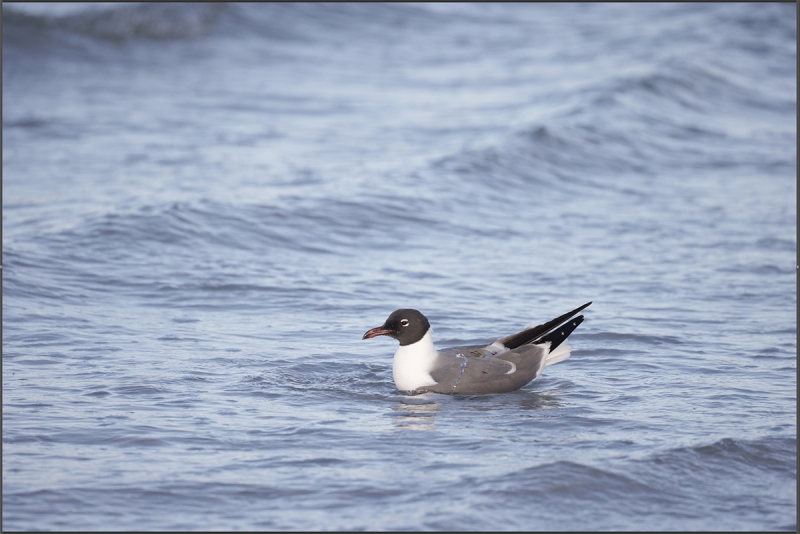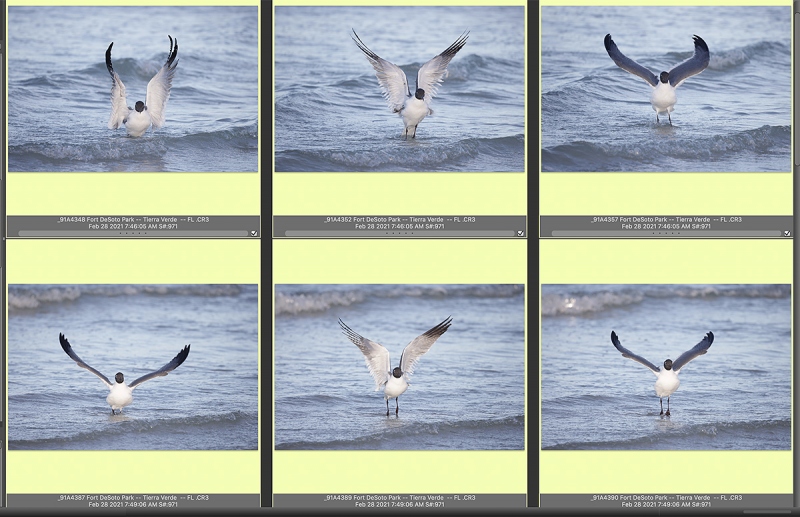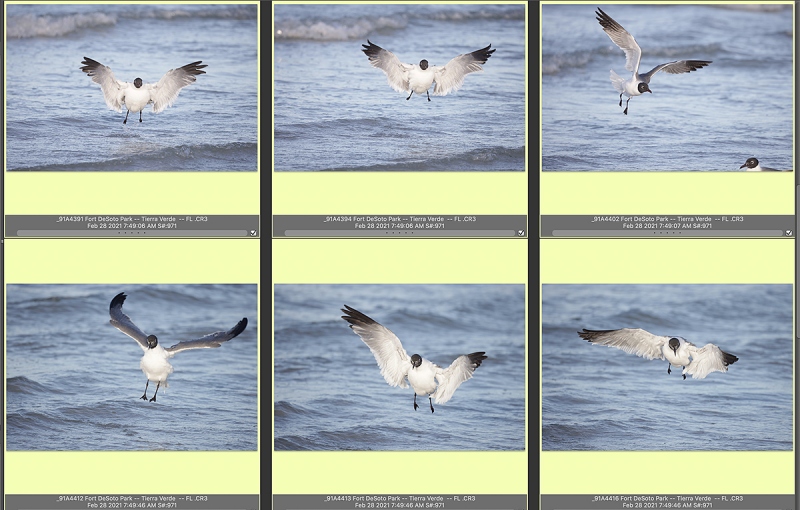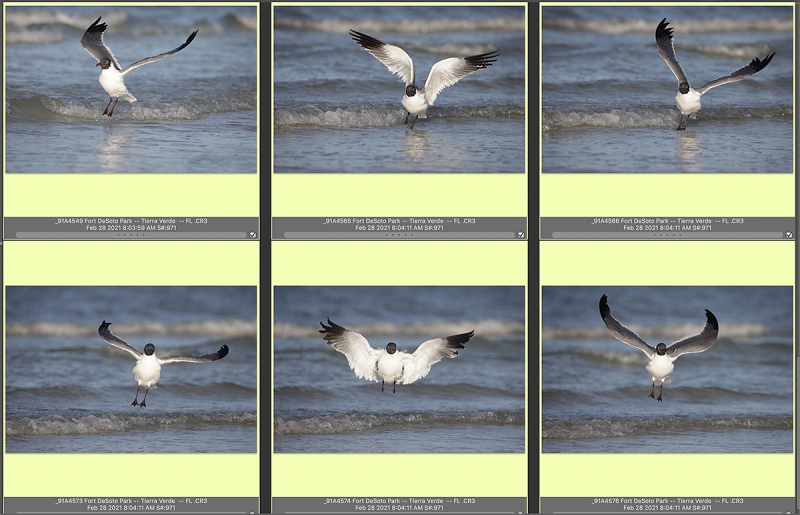Give it a Go
If — after reading and learning from this blog post — you would like to improve your editing/picking your keepers skills, please leave a comment denoting what you think is the strongest image in each of the three groups. And let us know why you made your choices. You can indicate your choice with the GROUP and file number, like this: GROUP 1 — 4389. I like the wing position and the way the bird is framed by the waves.
Canon R6 Bodies in Stock now at Bedfords/R5 Bodies on the Way!
Steve Elkins asked me to let you know that he is receiving a good number of Canon EOS-R6 bodies today. Get yours by clicking here. Enter the BIRDSASART discount code at checkout, save 3%, and enjoy free second-day air Fed-Ex shipping. And shoot me your receipt to receive your free copy of the R5/R6 AF e-Guide and save $65.00 off the price of the R5 User’s e-Guide.
Six R5 Bodies are on the way as well …
What’s Up?
It was mostly grey on Tuesday morning with the sun trying to peek through on occasion. Both crane families are doing well. I took a zillion mostly bad images of Cattle Egrets as there was a big hatch of small mayflies. I got a very few decent flight shots and one different image that I think is really neat. I will share that one with you here soon.
I worked long and hard all morning but don’t ask me on what. I often find myself wishing that there were 48 hours in a day. Sunset was totally grey, so I stayed home.
Today is Wednesday 3 March 2021. The forecast for this morning is for cloudy-dark with SW winds and scattered thunderstorms. I may head down early for a walk and then get back to work.
Wherever you are and whatever you are doing, I hope that you have a great day.
This blog post took more than two hours to prepare and makes seventy-two days in a row with a new one. Please remember …
Please Remember
With income from IPTs now at zero, please, if you enjoy and learn from the blog, remember to use one of my two affiliate programs when purchasing new gear. Doing so just might make it possible for me to avoid having to try to get a job as a Walmart greeter and will not cost you a single penny more. And if you use Bedfords and remember to enter the BIRDSASART code at checkout, you will save 3% on every order and enjoy free second-day air shipping. In these crazy times — I am out at least forty to sixty thousand dollars so far due to COVID 19 (with lots more to come) — remembering to use my B&H link or to shop at Bedfords will help me out a ton and be greatly appreciated. Overseas folks who cannot order from the US because of import fees, duties, and taxes, are invited to help out by clicking here to leave a blog thank you gift if they see fit.
The BAA Used Gear Page
The Used Gear page continues to be very active. The BAA Used Gear Page is the place to sell your used photographic equipment. We will help you to get your gear sold quickly for 20 to 60% or more than what the big guys are offering … Doubt me? Check out the Recent Sales list for the past thirteen months at the bottom of the page.
Price Drop
Canon EOS 5D Mark II Digital SLR Camera Body with Extras!
Price Reduced $100 on 2 NOV 2020!
Price Reduced $100 on 1 MAR 2021!
Stuart Hahn is offering a Canon 5D Mark II in excellent plus condition for a silly-low $385.00 (was $585.00). The LCDs have been protected with screen protectors since day one. The sale includes everything that came with the camera originally, a RRS L bracket, and insured ground shipping via major courier to lower-48 US addresses only. Your item will not ship until your check clears unless other arrangements are made.
Please contact Stu via e-mail or by phone at 1-916-485-1630 (Pacific time zone).
Stu Hahn was the first-ever seller on the Used Gear Page many years ago when he parted with his Canon 500mm f/4L IS lens, the “old five.” This 5D II body would be ideal for a budding landscape or Urbex photographer, as well as for some looking for a great body to convert to IR. My 5D II was expertly converted by Kolari Vision. It is also a very good body for bird and nature photography; I used mine as a back-up for my old 1D Mark IV bodies. It served me very well in that capacity in the Southern Ocean a while back when I foolishly used my two 1D IVs in a driving rainstorm for two hours with the expected result. That 5D II saved the trip for me. Stu’s body is priced to sell. artie
Canon EOS R5 Camera User’s e-Guide
On Thursday, I sent out about a dozen copies of the almost finished Canon EOS R5 Camera User’s e-Guide for review to folks who had previously gotten free copies of the R5/R6 AF e-Guide by using my affiliate links to purchase their Canon mirrorless gear. In the same vein, I will be contacting everyone who purchased the R5/R6 AF e-Guide on Monday.
Because the camera and the Menus are so complex, this guide has required a ton of research, a lot of time, and a lot of effort (and will continue to do so until it is complete). It should be finished by the first week in March. 2021. The final update of the R5/R6 AF e-Guide has become part of the complete Camera User’s e-Guide; it will be revised if warranted.
The complete Camera User’s guide will sell for $75.00. Folks who purchased their Canon gear using my links will receive a $65.00 discount; the guide will cost them a nominal $10.00. Folks who spent more than $7500.00 on Canon mirrorless gear using either of my affiliate links (B&H or Bedfords), will receive the User’s Guide for free. Folks who purchased the R5/R6 AF e-Guide will receive a $10.00 discount on the User’s e-Guide. The best news is that the end is in sight.
New and Better Bedfords Discount Policy!
You can now save 3% on all of your Bedfords photo gear purchases by entering the BIRDSASART coupon code at checkout. Your discount will be applied to your pre-tax total. In addition, by using the code you will get 2nd day air shipping via Fed Ex.
Grab a Nikon AF-S Teleconverter TC-14E III and save $14.99. Purchase a Canon EOS R5 and your discount will be $116.97. Purchase a Sony FE 600mm f/4 GM OSS lens and save a remarkable $389.94! Your Bedford’s purchase no longer needs to be greater than $1,000.00 for you to receive a discount. The more you spend, the more you save.
Money Saving Reminder
Many have learned that if you need a hot photo item that is out of stock at B&H, would like a 3% discount, and would enjoy free second-day air shipping, your best bet is to click here, place an order with Bedfords, and enter the coupon code BIRDSASART at checkout. If an item is out of stock, contact Steve Elkins via e-mail or on his cell phone at (479) 381-2592 (Central time). Be sure to mention the BIRDSASART coupon code and use it for your online order to save 3% and enjoy free 2nd-day air shipping. Steve has been great at getting folks the hot items that are out of stock at B&H and everywhere else. The wait lists at the big stores can be a year or longer for the hard to get items. Steve will surely get you your gear long before that. For the past year, he has been helping BAA Blog folks get their hands on items like the SONY a9 ii, the SONY 200-600 G OSS lens, the Canon EOS R5, the Canon RF 100-500mm lens, and the Nikon 500mm PF. Steve is personable, helpful, and eager to please.


Gear Questions and Advice
Too many folks attending BAA IPTs (remember those?) and dozens of photographers whom I see in the field and on BPN, are–out of ignorance–using the wrong gear especially when it comes to tripods and more especially, tripod heads… Please know that I am always glad to answer your gear questions via e-mail. Those questions might deal with systems, camera bodies, accessories, and/or lens choices and decisions.
|
|
|
This image was created on 28 February 2021 at Fort DeSoto Park, Tierra Verde, FL on my In-the-Field morning with Steve King. I used the handheld Canon RF 100-500mm f/4.5-7.1L IS USM lens and the highly touted 45MP Canon EOS R5 Mirrorless Digital camera body. ISO 1600. Exposure determined by test image histogram check: 1/2000 second at f/7.1. Center Zone/AI Servo AF performed quite well. Framing for after-bath flapping |
Initial Framing for Flapping-After-Bath Images
The image above shows approximately how you want to frame the bird while it is bathing; note that I have given the bird room to jump up into the frame. If you approach any closer, you will surely be clipping wings. With both Canon and SONY, center zone is my choice for the flapping-after-bath images. Note that you have some (up & down and side to side) latitude in framing with center zone. Thus, I was able to place the bird nicely down and slightly to the right (in the frame).
It almost goes without saying that you want the light and the wind coming from behind you so that the bird will flap while facing you and flapping into the wind.
If a bird is flapping vigorously, you may wish to move closer or add a teleconverter to go for the dramatic splashing shots. But you will surely miss the after-bath flapping images if you do. Zooming out rapidly in those situations is a huge challenge at best. I recommend that you go for one or the other.
|
|
|
These six images were created on 28 February 2021 at Fort DeSoto Park, Tierra Verde, FL on my In-the-Field morning with Steve King. For all of the images in this screen capture I used the handheld Canon RF 100-500mm f/4.5-7.1L IS USM lens and the highly touted 45MP Canon EOS R5 Mirrorless Digital camera body. All in this series were created at 1/2000 second at f/7.1 with ISOs of either 2000 (for the first three images) or 1600 (for the bottom three images). Center Zone/AI Servo AF performed quite well. Click on the screen capture to view a larger version. Laughing Gulls flapping-after-bath GROUP A |
Setting the Exposure with ISO on the Rear (Thumb) Wheel
Note with all three groups that after setting the shutter speed and the aperture (all wide open at f/7.1), I set my exposures by using ISO on the rear (thumb) wheel, just as I do with SONY. Taking a look at the EXIF for all three groups, you can see that the morning got brighter as time went by. For Canon, that means that you need to make a test exposure and evaluate the histogram every time the light changes. And when the light is changing almost second by second as a cloud passes in front of the sun, you will have to guesstimate. With SONY it is faster, simpler, and far more efficient to change the ISO as the light changes based on live Zebras in the viewfinder; you do not have to create a test image and evaluate the histogram. SONY folks can learn exactly how to do that in the Sony Camera User’s e-Guide and One Camera Set-up Video or the Sony Camera User’s e-Guide and Two Camera Set-up Videos.
Why not use the live, in-viewfinder histogram with the Canon R5?
Folks might ask, Why not use the live, in-viewfinder histogram with Canon? There are lots of problems with that approach. You have a choice of a small or a large histogram. The larger one is easier to read, but both cover a good portion of the frame; this obstructs your view and makes it difficult to design the image you want. But the major problem is that even with the large histogram, the right- (highlight-) end of the histogram is not depicted accurately. On numerous occasions, the histogram shows plenty of room on the right, but when you make an image, you will often find that it is a gross over-exposure.
|
|
|
These six images were created on 28 February 2021 at Fort DeSoto Park, Tierra Verde, FL on my In-the-Field morning with Steve King. For all of the images in this screen capture I used the handheld Canon RF 100-500mm f/4.5-7.1L IS USM lens and the highly touted 45MP Canon EOS R5 Mirrorless Digital camera body. All in this series were created with ISOs of either 1600 (for the first three images) or 1250 (for the bottom three images). Center Zone/AI Servo AF performed quite well. Click on the screen capture to view a larger version. Laughing Gulls flapping-after-bath GROUP B |
20 Frames-per-Second Editing
Even though I am conservative with regards to pressing the shutter button, I often find myself making well more than a thousand images during a decent session. I choose my keepers in Capture One. Once all the files in a folder load, you can pretty much view the images at slide-show-speed. I use T to red-tag my keepers. At times I slow down a bit to open an image in RawDigger to check the exposure. That done, I can correlate what I have learned in RawDigger with the red highlight warnings in Capture One. Assuming that you know what you are looking for (see item-next for help with that), it is possible to edit large folders in warp-speed time. I created more than 1800 images on my morning with Steve. I chose my 161 keepers in about 12 minutes. In time, that number will be reduced to about 50 after a second round of editing.
|
|
|
These six images were created on 28 February 2021 at Fort DeSoto Park, Tierra Verde, FL on my In-the-Field morning with Steve King. For all of the images in this screen capture I used the handheld Canon RF 100-500mm f/4.5-7.1L IS USM lens and the highly touted 45MP Canon EOS R5 Mirrorless Digital camera body. All in this series were created at 1/3200 second at f/7.1. The first image was created at ISO 800, the last five at ISO 640. Center Zone/AI Servo AF performed quite well. Click on the screen capture to view a larger version. Laughing Gulls flapping-after-bath GROUP C |
What Makes a Good Flapping-after-bath Image?
1- Is the subject relatively centered without any clipping of feet or wings? Is it facing forward or flying away?
2- Is the head sharp?
3- Is the flapping pose/wing position interesting, artistically pleasing, or dramatic (or relatively boring)?
4- Does the position of the feet & legs add something special?
5- Is one, or are both eyes, visible?
6- Do the background waves and wavelets add something to the motif or are they distracting?
7- Is the subject isolated? If not, can the image be saved with a small crop? Having other birds or man-made objects like piers or boats in the background is generally (but no always) an image-killer.
8- If the sun is out, are the underwings evenly illuminated? Harsh shadows are big negatives.
9- The condition of the subject and the plumage stage.
Even a single “no” answer to any of the questions above (except for #s 4 & 9), will usually result in an insta-pass-it-by delete. Six or seven yeses usually mean a red-tagged keeper. Eight or more positive responses and you just might have a family jewel.
Give it a Go
If you would like to improve your editing/picking your keepers skills, leave a comment denoting what you think is the strongest image in each of the three groups. And let us know why you made your choices. You can indicate your choice with the GROUP and file number, like this: GROUP 1 — 4389. I like the wing position and the way the bird is framed by the waves.
Typos
In all blog posts and Bulletins, feel free to e-mail or to leave a comment regarding any typos or errors.



















A – 4389 – Angelic; head appears to be looking at the camera (these are small thumbnails).
B – 4394 – Fat boy landing (No offense).
C – 4574 – Symmetry and nice boiling waves
Artie,
Do you know what the Canon live histogram is actually reading from? I cannot seem to find the answer to that question …. might shed some light as to why it is inaccurate.
As far as I know, from the embedded jpeg — I think that that is the only possibility …
If you push the Canon histogram all the way to the right what has RAWDigger revealed about the number of over and under exposed pixels in most images?
We never worry about under-exposed pixels. What burns me often (pardon the pun) with R5 images is serious over-exposures; I had a ton of them this morning photographing Cattle Egrets in the rain. And the histogram is not only inaccurate (from where I am sitting), but it is inconsistent as well. My strategy for coming up with reasonably good exposures is a simple one and will be reveled in the R5 Camera User’s e-Guide. It is one of the last things that I need to do to finish.
I think many cameras have 2-3 stops of built in “headroom” such that over exposed areas can be recovered (up to to a point).
I cannot agree with that at all. Each system is different. That’s where RawDigger comes in — the raw histogram never lies.
I don’t know where the R5 is calibrated on that issue.
My opinion on that (in so many words) will be covered in the R5 Camera User’s e-Guide (as noted above).
Have you been using FastRAWViewer as part of your workflow process or just RAWDigger?
Just the former. Patrick might be using both …
Thanks
YAW; with love, a
Group A – 4389 – Good head and wing position and no distracting waves.
Group B – 4413 – Interesting and unique bird position.
Group B – 4402 – This is a good clean shot and can be cleaned up with small crop from bottom right.
Group C – 4549 & 4574 I like both for different reasons…
Good stuff. Many thanks. Much love,
a
Group #1 : I prefer open wings
1. 4352
2. 4348
3. 4389
4. 4357 (would probably keep)
Group #2
1. 4413
2. 4394
3. 4412
Group #3
1. 4574 (My preferred one in all these)
2. 4565
3. 4576
In this exercise, I have realized that I prefer the shots showing the interior of the wings.
thanks!
Yves, Thanks for leaving a comment.
Does this:
1. 4352
2. 4348
3. 4389
4. 4357 (would probably keep)
mean that you would keep the other three in the group of delete them?
with love, a
I would probably keep Them but would not process Them. Given the fact that they are Sharp, I would keep Them. I keep a lot of photos, thrash the “out of focus and/or Cut Wings” ones.
Thanks Yves for checking back. Just for the record all of the images in all three groups are clear keepers by my standards. I realize that presenting them small does not enable folks to see just how good each and every image is. I should have emphasized the fact that at 20 fps with amazing AF you are gonna get a lot of really good images, and thus the importance of tight editing.
with love, artie
Thanks Artie for your answer. Real good stuff to LEARN here for me! Thanks again!
YAW. Thanks for being open and understanding. with love, artie
I actually like the histogram options in the EVF, but you are 100% correct in that it doesn’t seem accurate for the 12-bit RAW (or CRAW) format. I don’t really use the 13 & 14-Bit mechanical shutter modes so I can’t speak to that. But I’m finding the real highlight limit is somewhere around 45-55% of the final box. Hopefully enough people make a fuss about this and make Canon address it in someway. I also agree that Zebra’s or even just a normal Canon Highlight Warning (blinkies) would be ideal in the EVF. I’d assume both issues wouldn’t take much in the form of a software update to resolve. Here’s to hoping.
Hi Mike,
I doubt that they are accurate in any-bit 🙂 Another problem is that the stuff in the fifth box is inconsistent … You are missing one important point: “normal” Canon Highlight Warning (blinkies) in the EVF would be Zebras! So not normal for Canon. Their only blinkies are after the fact.
As far as hoping for any camera manufacturer to listen to solid reasoning and make changes — good luck. It ain’t gonna happen.
with love, artie
ps: I hope I am wrong but …